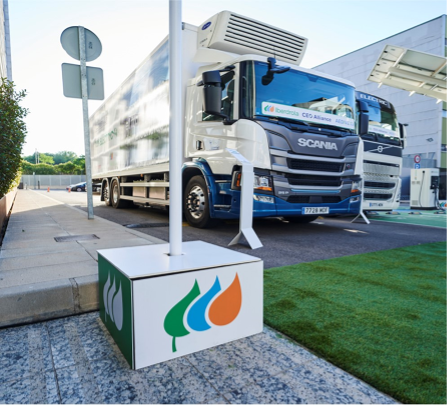For the EU to reach climate neutrality by 2050, one condition is to cut transport GHG emissions by 90%, and that means shifting to zero-emission mobility.
Eliminating emissions from heavy-duty vehicles will be a game changer. In the EU heavy duty trucks amount to only 1% of the total vehicle fleet, but to approximately a quarter of CO2 emissions and of energy consumption of road transport.
Instead of decreasing, emissions in this sector have actually increased every year since 2014. For trucks, the primary cause of this trend is a growing demand for freight transport (85% of EU road freight transport is carried out by trucks), which has become the backbone of trade and commerce on the European continent. Freight transport is expected to increase by 33% by 2030 and 55% by 2050 – with clear implications also for emissions.
The good news is that in the energy transition, heavy duty vehicles are no longer a ‘hard-to-abate’ sector. The switch to electricity (electric batteries) or hydrogen (fuel cells) has become technologically possible, scalable and economically feasible. EV batteries are already 85% cheaper than 10 years ago, and by 2030 driving a battery electric truck (BET) is likely to be less expensive than driving a diesel truck. Range anxiety will abate, too, as by 2025-2027, a 40-tonne truck will be able to drive 800 km on a single charge. Charging technology is also catching up: new megawatt charging stations will make it possible for an electric long-haul truck to complete the same distance per day as a diesel truck (and only use half the energy).
The technological solutions lie in our hands, and yet there is a catch: ex-ante deployment. The charging infrastructure needs to be in place in advance – otherwise the market switch to electric trucks will likely not take place.
Innovation deployment: a value chain effort
Iberdrola is leading a CEO Alliance project – a value chain effort – to promote the development of a new charging infrastructure in the southern part of the EU’s Trans-European Transport Network (TEN-T). This is being done in a consortium with Enel, Scania, ABB and Unicredit.
The first tangible deliverable of the project is the deployment of a charging infrastructure along one third (1008km) of the Mediterranean Corridor, TEN-T’s main East-West axis south of the Alps, and provides a multimodal link for the ports of the Western Mediterranean with the Central Europe. The project foresees the deployment of 22 charging stations with an installed capacity of 6 to 8MW per location. The initially proposed deployment in the Mediterranean Corridor assumes an installed capacity of 150 MW with an investment of €110M, of which approximately €50M would be network reinforcement and extension investment. The project could additionally incorporate, if the regulatory conditions are adequate, an advance of investments in network extension and reinforcement in the rest of the Spanish corridors of approx. €200M.
Second, it is key to link up the entire value chain. Iberdrola has promoted the Alliance for the electrification of the EU TEN-T corridors, open to all the sectors needed: charging infrastructure and truck manufacturers, logistics companies, public administrations, distribution system operators (DSOs), charging point operators (CPOs) and utilities, etc. The Alliance will promote the formation of various working groups, one per country (Spain, France, Italy) to address the specificities of each country (regulation, permits, etc.) and to put in contact different stakeholders in the value chain to speed up the transition from fossil fuel to battery electric trucks. Also, bottlenecks that hinder the electrification of heavy transport need to be identified. A dedicated EU Committee will bring priority matters to the attention of the European Commission.
Traditionally, electric companies and logistics operators have not been regular partners, but agreements can be established. Under the umbrella of the Alliance for the electrification of the EU TEN-T corridors, agreements signed between Iberdrola and the logistics operators Disfrimur and Primafrío with the inclusion of OEMs (original equipment manufacturers) such us Scania or Volvo, showcase what such partnerships can support and drive.
Where Europe needs to pull together, stronger
Making freight transport emission-free is not optional – it is a necessity for Europe to reach its climate goals. Success depends, among other factors on truck technology and the availability of green energy.
And success also depends on our ability to cast a new charging infrastructure network across Europe, before it is even needed on a day-to-day basis. From a technology point of view, we can do this. But there are many hurdles on the way.
We still see a disconnect between political priorities on the one hand and, on the other, public-sector follow-through to help achieve them – and do so with urgency. This disconnect toughens the deployment challenge and sends the wrong signal to the market – at least in Europe. Some examples:
Why does it still take three to five years to obtain permits to commission recharging points? Why does it take longer to obtain a permit for grid extension, building and operating charging infrastructure than to actually design and construct it (18 months vs six months)?
And is the public sector stepping up to help solve the chicken-and-egg problem? Is there enough recognition of what it takes in terms of public resources to help transition into a zero-emission freight truck scenario? Both, the investment in charging infrastructure and acquisitions of trucks require extraordinary support: 30%-40% of this needs to come from public funding.
Most innovation cannot pay for itself from day one. And in our case, deployment cannot grow with demand, as by definition freight trucks deliver goods to anywhere and therefore need to be chargeable everywhere from day one. For zero-emission freight trucks to become normal tomorrow, we need to achieve the extraordinary today – and for that public and private sector have to push together.


